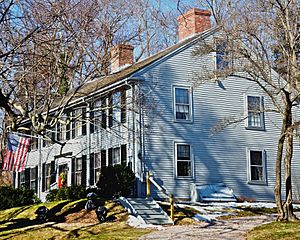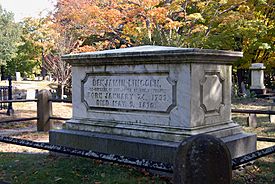Benjamin Lincoln facts for kids
Quick facts for kids
Benjamin Lincoln
|
|
|---|---|

1784 portrait by Charles Wilson Peale
|
|
| 1st Collector of the Port of Boston | |
| In office 1789–1809 |
|
| Preceded by | Position established |
| Succeeded by | Henry Dearborn |
| 2nd Lieutenant Governor of Massachusetts | |
| In office 1788–1789 |
|
| Governor | John Hancock |
| Preceded by | Thomas Cushing |
| Succeeded by | Samuel Adams |
| 1st United States Secretary at War | |
| In office March 1, 1781 – November 2, 1783 |
|
| Preceded by | Position established |
| Succeeded by | Henry Knox |
| 1st Clerk of the Massachusetts Provincial Congress | |
| In office October 7, 1774 – May 31, 1775 |
|
| Preceded by | office established |
| Succeeded by | Samuel Freeman |
| Committee of Safety | |
| In office October 7, 1774 – February 1, 1775 |
|
| Constituency | At-large (Commissary Officer) |
| Personal details | |
| Born | January 24, 1733 Hingham, Massachusetts Bay, British America |
| Died | May 9, 1810 (aged 77) Hingham, Massachusetts, U.S. |
| Political party | Federalist |
| Spouse |
Mary Cushing
(m. 1756) |
| Signature | |
| Military service | |
| Allegiance | |
| Branch/service | Massachusetts Bay militia |
| Years of service | Militia (1755–1777) Continental Army (1777–1781) |
| Rank | Major general |
| Commands | Massachusetts provincial militia Bound Brook Southern Department |
| Battles/wars | American Revolutionary War • Boston campaign • Battle of White Plains • Battle of Bound Brook • Second Battle of Saratoga (Bemis Heights) • Siege of Savannah • Siege of Charleston • Yorktown campaign Shays' Rebellion |
Benjamin Lincoln (born January 24, 1733 – died May 9, 1810) was an important American army officer. He served as a major general in the Continental Army during the American Revolutionary War. Lincoln was part of three major events during the war. He helped with the Battles of Saratoga, which led to the British army's surrender. He also oversaw the largest American surrender of the war at the 1780 Siege of Charleston. Later, as George Washington's second-in-command, he formally accepted the British surrender at Yorktown.
After the war, Lincoln served as the first United States Secretary at War from 1781 to 1783. He was also active in politics in Massachusetts. In 1787, he led a militia to stop Shays' Rebellion. He strongly supported the new United States Constitution. For many years, he was the customs collector for the Port of Boston. He is not related to Abraham Lincoln.
Contents
Early Life and Public Service
Benjamin Lincoln was born on January 24, 1733, in Hingham. He was the sixth child and first son of Colonel Benjamin Lincoln. His family was among the first to settle in Hingham. His father was a wealthy man who held many important civic jobs.
Lincoln worked on the family farm and went to the local school. He became a town constable at age 21. In 1755, he joined the local militia, where his father was a colonel. In 1756, at age 23, Lincoln married Mary Cushing. They had eleven children, and seven lived to be adults. He became the town clerk of Hingham in 1757, a job he held for twenty years. He was active in the militia during the French and Indian War but did not fight. He was promoted to major by 1763.
In 1765, Lincoln was elected a Hingham town selectman. He held this job for six years. During this time, people in the colony began to oppose new taxes from the British Parliament. Lincoln supported the opposition, becoming a leader among Hingham's Patriots. In 1770, he helped create resolutions against importing British goods. He also spoke out against the Boston Massacre. In 1772, he was promoted to lieutenant colonel in the militia. That same year, he was elected to represent Hingham in the provincial assembly.
Role in the American Revolution
In 1774, the provincial assembly was dissolved by Governor Thomas Gage. It then became the Massachusetts Provincial Congress. Lincoln continued to be elected to this group. He was placed on committees that organized and supplied the militia. This became very important when the American Revolutionary War began in April 1775. He was also on the committee of safety and the executive council. He worked hard to get supplies like blankets and gunpowder for the new Continental Army outside Boston.
Defending New York
In January 1776, Lincoln became a major general of the Massachusetts militia. He was in charge of the state's coastal defenses. After the British left Boston, he helped improve the state's forts. In May 1776, he led forces that drove the last British ships from Boston Harbor.
Lincoln wanted to join the Continental Army. In September 1776, he led a militia brigade to join General George Washington in New York Town. Lincoln's troops helped the Continental Army retreat safely to White Plains, New York. They were part of the main army during the Battle of White Plains in October 1776. Based on Washington's recommendation, Congress made Lincoln a major general in the Continental Army on February 14, 1777.
Lincoln's first command was an outpost at Bound Brook, New Jersey. On April 13, 1777, his post was attacked by a larger British force. In the Battle of Bound Brook, he was defeated and barely escaped capture.
Saratoga Campaign
In July 1777, Washington sent Lincoln north to help defend upstate New York against General John Burgoyne's army. Lincoln was to organize the New England militia. He was asked to disrupt the British supply line as they moved south. Lincoln's job was difficult because a New Hampshire militia leader, John Stark, refused to be under his command.

By early September, Lincoln had 2,000 men. He sent groups to attack the British supply line. One group, led by Colonel John Brown, attacked British positions near Fort Ticonderoga. They freed American prisoners. By this time, General Horatio Gates ordered Lincoln to join him near Stillwater, New York. Lincoln arrived on September 22, after the Battle of Freeman's Farm. Lincoln's militia held the eastern side of the Hudson River.
Lincoln's militia did not fight in the October 7 Battle of Bemis Heights. The main fighting was on the western side of the river. Lincoln was in command of the American right side. American forces broke through the British defenses, forcing Burgoyne to retreat. That evening, Lincoln's 1,500 men moved into the former British lines. He suggested fortifying the ford at Fort Edward. Gates agreed and ordered Lincoln's militia to do it. During these movements, Lincoln was shot in his right ankle by a musket ball.
Lincoln was taken to Albany for treatment. He learned of Burgoyne's surrender on October 17. His son helped him return to Hingham in February 1778. His injury left his right leg two inches shorter than his left. For many years, the wound would reopen and risk infection. Lincoln considered leaving the army because of a seniority issue. But Washington and Congress convinced him to stay.
Southern Battles (1778–1781)
Lincoln rejoined Washington in August 1778. He was made commander of the Southern Department in September. Lincoln took part in the unsuccessful Siege of Savannah in October 1779. After this, he went to Charleston, South Carolina. He took command of the Charleston garrison. In March 1780, a large British force surrounded the city. After a short siege, Lincoln had to surrender over 5,000 men to Lieutenant General Sir Henry Clinton on May 12, 1780. However, he managed to help some South Carolina militia and Continental forces escape, which angered the British.
Lincoln had asked the South Carolina legislature for more troops. The loss of the southern army at Charleston was one of the worst American defeats of the war. Lincoln was not given the usual honors of war when he surrendered. This was because he helped some American forces escape. Lincoln was later released. A review of his actions found no fault with him.
After being exchanged for a British general in November 1780, Lincoln returned to Washington's main army. He led a large part of the army south to Yorktown, Virginia. Lincoln played a major role in the siege of Yorktown and the surrender of Lord Cornwallis on October 19, 1781. Cornwallis claimed to be sick and did not attend the surrender. He sent his second-in-command, General Charles O'Hara. General Washington refused to accept Cornwallis's sword from O'Hara. Instead, he told O'Hara to give it to Lincoln, who was Washington's own second-in-command.
Secretary at War (1781–1783)
From 1781 to late 1783, Lincoln was the first United States Secretary at War. He was appointed by the Confederation Congress under the Articles of Confederation. He was later replaced by Henry Knox. In 1781, he became a member of the American Academy of Arts and Sciences.
While Secretary at War, Lincoln became a founding member of The Society of the Cincinnati in Massachusetts. He was elected the first president of the Massachusetts Society on June 9, 1783. He also supported the election of George Washington as the first President General of The Society of the Cincinnati.
After the War
In early 1787, Lincoln helped end Shays' Rebellion. This was an uprising of farmers in western Massachusetts who were against high taxes. Lincoln led 3,000 privately funded militia to stop the rebels. He captured over one hundred of them. This rebellion caused a national stir. It helped show the need for a stronger national government, leading to the Constitutional Convention. The next year, Lincoln voted to support the United States Constitution at the Massachusetts Federal Convention.
On February 4, 1789, Lincoln received one electoral vote in the first election for President and Vice President of the United States. This vote came from an elector in Georgia.
Lincoln also served as one of the first trustees of Derby Academy. This school was founded in Hingham. He remained active in public life in various roles. He served a term as Lieutenant Governor of Massachusetts. He also spent many years as the Collector of the Port of Boston. He retired from public life in 1809 and died in Hingham on May 9, 1810.
Legacy and Recognition

Lincoln is buried in the Old Ship Burying Ground in Hingham. Important people like John Adams were pallbearers at his funeral. In his honor, bells were rung in Boston, and flags were lowered to half-mast.
He was one of the few people involved in the three major surrenders of the American Revolutionary War. He was a victor twice (at Yorktown and Saratoga) and the defeated party once (at Charleston). Despite his important role, he is not as well-remembered as some other figures from the Continental Army.
He was a founding member of The Massachusetts Society for Promoting Agriculture (M.S.P.A.). This was one of the first farming societies in the United States.
Many places in the American South are named after Benjamin Lincoln. These include counties and towns in Alabama, Georgia, Kentucky, Missouri, North Carolina, and Tennessee. Communities in North Carolina (Lincolnton), Georgia (Lincolnton), Vermont (Lincoln), and Maine (Lincolnville) also bear his name. Streets in Columbia, South Carolina, and Savannah, Georgia (Lincoln Street) are named after him. Lincoln Hall at the United States Coast Guard Training Center in Yorktown, Virginia, is also named in his honor.
Lincoln's childhood home still stands today. It was named a National Historic Landmark in 1972.
See also
 In Spanish: Benjamin Lincoln para niños
In Spanish: Benjamin Lincoln para niños



